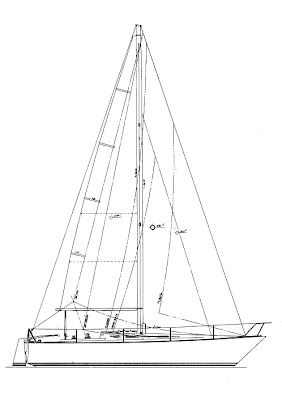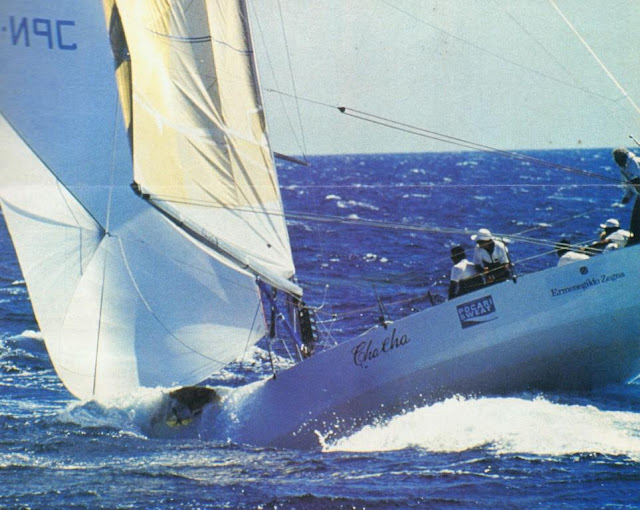 Terrorist was a radical IOR yacht designed by Bruce King in 1973. She featured twin asymmetric centreboards, angled outwards at 12 degrees and 'toed in' at 3 degrees to the centreline. Terrorist introduced the concept of internal ballast, a considerable change from keeping ballast as low as possible in a keel. The boards could be lifted independently or linked by a connected system that lifted the weather foil while the leeward foil stayed deep in undisturbed water, and combined with the slight angle to the centreline the boards created tremendous lift to weather. Off the wind both foils were retracted to reduce drag and wetted surface. Despite being an odd boat - short (10.8m LOA), wide (3.9m beam), high-wooded and relatively light (4,765kg), she was seen as a real threat in the 1974 One Ton Cup held in Tourquay.
Terrorist was a radical IOR yacht designed by Bruce King in 1973. She featured twin asymmetric centreboards, angled outwards at 12 degrees and 'toed in' at 3 degrees to the centreline. Terrorist introduced the concept of internal ballast, a considerable change from keeping ballast as low as possible in a keel. The boards could be lifted independently or linked by a connected system that lifted the weather foil while the leeward foil stayed deep in undisturbed water, and combined with the slight angle to the centreline the boards created tremendous lift to weather. Off the wind both foils were retracted to reduce drag and wetted surface. Despite being an odd boat - short (10.8m LOA), wide (3.9m beam), high-wooded and relatively light (4,765kg), she was seen as a real threat in the 1974 One Ton Cup held in Tourquay.
Her wide beam provided additional stability - although she had a high ballast ratio the weight wasn't carried deep in the hull so its effect was minimised. Because of her wide beam the boat had to accept some trade-off in light airs in terms of wetted surface, but in a breeze the boat was almost unbeatable.
 |
| One Ton Cup 1974 (Sea Spray) |
But Terrorist also appeared competitive even in light winds against the types of boats predominant at the 1974 event and she won the first race of the One Ton Cup by nearly five minutes. Yachting journalist Jack Knights reported that fellow American crews were surprised that she had been able to win in light air - everybody else was amazed that the boat could win at any time. However, a broken mast in the short ocean race, which ruled her out of the following race as well, prevented any chance of an overall win. This let the Peterson design Gumboots through to take the Cup that year.

The long term future of Terrorist was seriously affected by the introduction of a 'moveable appendage factor' (MAF) to the IOR later in 1974, which raised her rating out of the One Ton rating limit of 27.5ft. Because she had been penalised out of the One Ton class, the owner, Al Cassell, decided to remove the hastily repaired old mast and to increase the height of her rig by about 2 feet to improve her light air performance. This change, combined with the MAF penalty, boosted Terrorist's rating to about 29.5ft.
 |
| Terrorist seen here during the 1974 One Ton Cup (photo Facebook) |
 |
| Terrorist on a tight reach (Carter Cassel Collection) |
 |
| Terrorist as she was found circa 2010 (photo Craig/CRM) |
 |
| Undergoing hull fairing in 2012 (photo Paul Tullos) Above and below - hull and decks all painted - February 2013 (photos Paul Tullos) |
Update 16 August 2013: The new carbon mast (by GMT Composites) was recently fitted and Terrorist is now back in the water:
















































